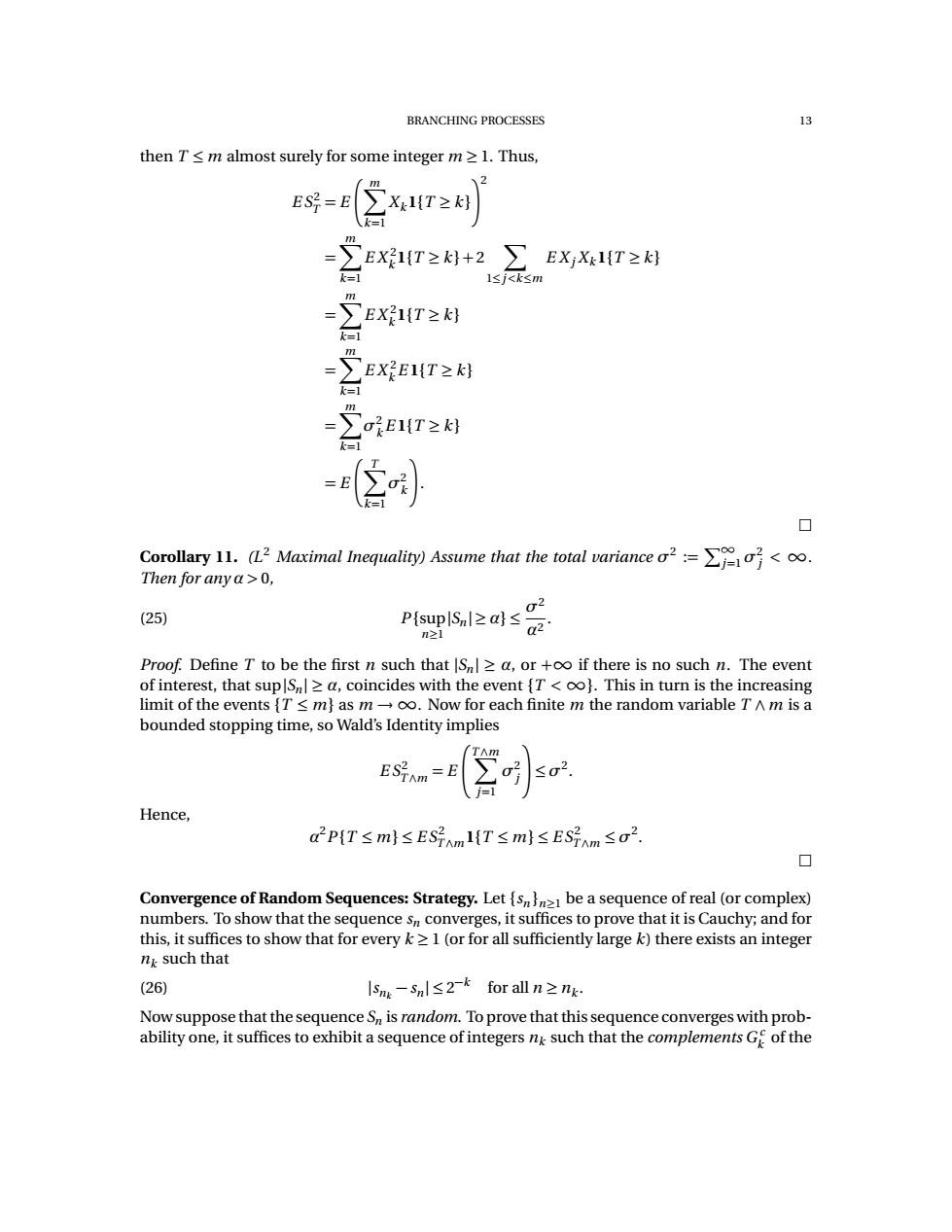正在加载图片...

BRANCHING PROCESSES 13 then T m almost surely for some integer m >1.Thus, =X1T≥k+2。 EX;Xk1{T≥k} 1≤j<k≤m m -会好1T≥4 -∑EXE1T24 ∑o2E1T4 口 Corollary 11.(L2 Maximal Inequality)Assume that the total variance =< Then for any a>0, (25) Pls.1≥a4s n21 a21 Proof.Define T to be the first n such that ISnl>a,or +oo if there is no such n.The event of interest,that suplSl>a,coincides with the event {T oo}.This in turn is the increasing limit of the events {T m}as m-oo.Now for each finite m the random variable T A m is a bounded stopping time,so Wald's Identity implies ES子Am Hence, ap{T≤m}≤ES号ml{T≤m}≤ES号m≤o2. ▣ Convergence of Random Sequences:Strategy.Let {s}1be a sequence of real(or complex) numbers.To show that the sequence sn converges,it suffices to prove that it is Cauchy;and for this,it suffices to show that for every k>1 (or for all sufficiently large k)there exists an integer nk such that (26) lsmk-snl≤2 for all n≥nk. Now suppose that the sequence Sn is random.To prove that this sequence converges with prob- ability one,it suffices to exhibit a sequence of integers nk such that the complements Ge of theBRANCHING PROCESSES 13 then T ≤ m almost surely for some integer m ≥ 1. Thus, E S2 T = E Xm k=1 Xk1{T ≥ k} 2 = Xm k=1 E X 2 k 1{T ≥ k} + 2 X 1≤j <k≤m E X j Xk1{T ≥ k} = Xm k=1 E X 2 k 1{T ≥ k} = Xm k=1 E X 2 k E 1{T ≥ k} = Xm k=1 σ 2 k E 1{T ≥ k} = E X T k=1 σ 2 k . Corollary 11. (L2 Maximal Inequality) Assume that the total variance σ2 := P∞ j =1 σ 2 j < ∞. Then for any α > 0, (25) P {sup n≥1 |Sn | ≥ α} ≤ σ2 α2 . Proof. Define T to be the first n such that |Sn | ≥ α, or +∞ if there is no such n. The event of interest, that sup|Sn | ≥ α, coincides with the event {T < ∞}. This in turn is the increasing limit of the events {T ≤ m} as m → ∞. Now for each finite m the random variable T ∧ m is a bounded stopping time, so Wald’s Identity implies E S2 T ∧m = E T X ∧m j =1 σ 2 j ! ≤ σ 2 . Hence, α 2P {T ≤ m} ≤ E S2 T ∧m 1{T ≤ m} ≤ E S2 T ∧m ≤ σ 2 . Convergence of Random Sequences: Strategy. Let {sn }n≥1 be a sequence of real (or complex) numbers. To show that the sequence sn converges, it suffices to prove that it is Cauchy; and for this, it suffices to show that for every k ≥ 1 (or for all sufficiently large k) there exists an integer nk such that (26) |snk − sn | ≤ 2 −k for all n ≥ nk . Now suppose that the sequence Sn is random. To prove that this sequence converges with probability one, it suffices to exhibit a sequence of integers nk such that the complements G c k of the��